Best gorilla trekking tours and safaris in Rwanda
I’ve been reckless at times across a lifetime of travelling, but nothing could prepare me for this moment | WATCH
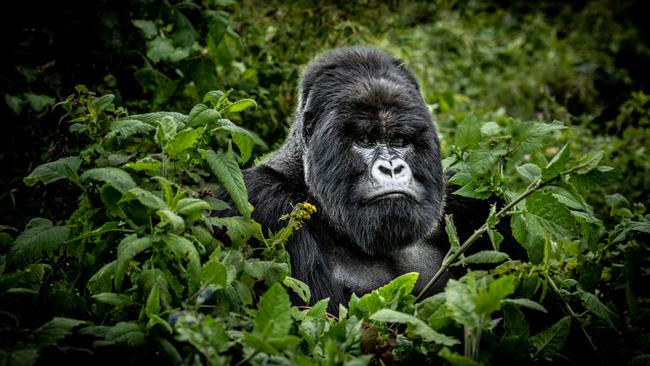
I have looked a silverback mountain gorilla in the eye and lived to tell the tale. Could there be an experience so simultaneously thrilling and terrifying? Such an unimaginable encounter must surely belong to the realms of fantasy but I find it mesmerising, as though I’ve been transported back to the very beginnings of time. My mind is cleansed, my pulse quickens, but there’s no fear. Just wonder and awe, and then I remember to exhale. It’s more like a wheeze and the silverback stares at me more intently. Oops.
Across a lifetime of travelling, from teenage backpacking to the more sedentary pursuits of mature age, I’ve been reckless on occasion, surprising myself with levels of energy that seem to kick in unsummoned. Survival mechanisms, perhaps? And here I am in Rwanda’s Volcanoes National Park on a Captain’s Choice private jet and rail itinerary of Africa, covering a broad trajectory from Cairo to Cape Town.
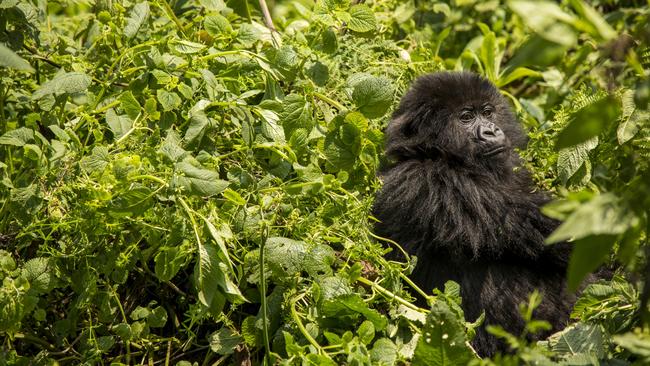
Our gorilla trekking group this day, divided into smaller mobs according to levels of easy, medium and (kind of) daredevil fitness, has been briefed, kitted up with water bottles, and assigned precise precincts of the mountain. At $US20 ($30) a pop, porters will carry any heavy gear such as camera equipment and oversized backpacks and assist climbers to navigate massive tree roots, dips and hollows, and then tackle the final stages, which could mean a tough climb.
The gorillas move about at will, of course, hardly just staying still to suit the capabilities of we intruders. They could be hanging around a field of potatoes beside a village or concealed in thick undergrowth somewhere near the clouds. Most of us opt for two porters each, one to push and the other to pull, and it’s not as silly as it sounds. We dress in “jungle” colours and look like superannuated army commandos.
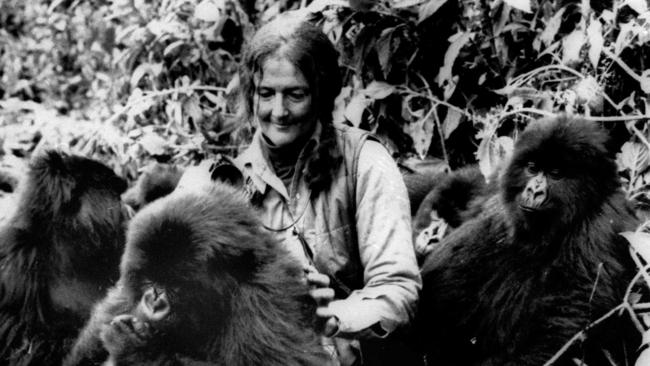
Conservationist and primatologist Dian Fossey first brought world attention to the plight of these majestic gorillas, and she paid the ultimate price, found murdered in 1985 at her cabin in Karisoke, on a ridge between the Karisimbi and Bisoke extinct volcanoes, where she lies buried beside Digit, her favourite silverback, killed by poachers in 1977. Her eponymous foundation and education centre, on an admirably eco-wise campus named for chief benefactor Ellen DeGeneres, lies adjacent to the national park and is worth visiting in advance of a climb to learn more of Fossey’s story and the history and evolution of “gorilla tourism”, which remains tightly controlled.
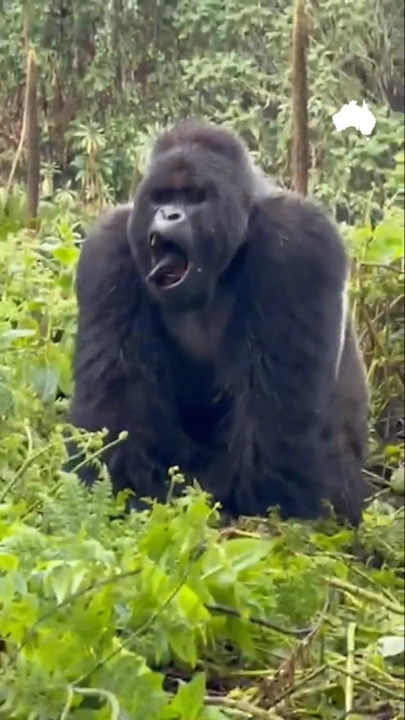
Foundation-funded trackers monitor the movements of groups and ensure their safety. We are delighted to attend a lecture by field veterinarian Dr Adrian Emile Ntwali of not-for-profit organisation Gorilla Doctors, who says his on-site health checks mostly reveal intestinal parasites, respiratory illness and infected wounds. Ntwali also advises that the trade of gorilla parts poached for the “traditional medicine” market in Asia was banned in the early 1990s by the government of Rwanda. Thanks to such ongoing vigilance, the mountain gorilla, although still endangered, is the only species of ape whose numbers are not in decline; the latest calculation is 1063 across Uganda, Rwanda and the Democratic Republic of the Congo, compared to about 680 three decades ago.
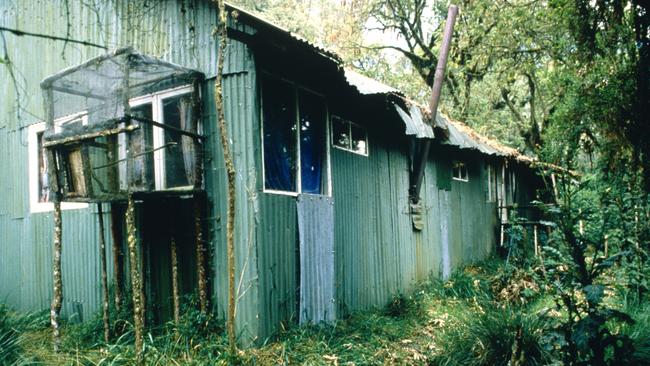
We have a full briefing at park headquarters and it is a trifle daunting, but none of us is deterred. There are 10 habituated gorilla families on the mountain and a maximum of eight visitors per assigned group of tourists. My porter Jean-Claude is sceptical of my footwear (and rightly so, as it transpires) and so we begin, on flat territory at first, then hitting a rise tangled with tree roots, which is when my arthritic left ankle seizes up and refuses to co-operate. No worries. Like a magician, Jean-Claude summons a basketlike arrangement from an adjacent village. It’s topped with a thin mattress and his mother has donated a sheet from her clothes-line patterned in dubious Louis Vuitton initials. He and a fellow porter hoist me aboard and up we go, my head kept low to avoid being smashed by overhanging branches. I’m not the only climber in need of this odd palanquin approach and we are soon delivered safely on to less treacherous ground. I am not sure how long we climbed in total as it could have been weeks, given the surrealistic surroundings and the lowering clouds. What happens if it rains? Well, just slide down on your derriere and avoid those tangled tree roots. Jean-Claude’s mother gets her laundry back, with a sizeable tip.

But we are fortunate this day and suddenly, yes, there really are gorillas in the mist, a family including a dominant silverback (King Kong movie flashbacks kick in as he stands up), a “blackback” male thumping his chest like a testosterone-fuelled teenager, two nursing mothers and a couple of juveniles scampering about. Our chief guide indicates we must put on face masks to ensure no transmission of germs; he casually adds that humans and gorillas share 98 per cent DNA. The creatures loll in their grassy “nests”, completely disinterested in our presence and, heck, we are really, really close, having suddenly crested a slope and stumbled, as it were, into this clearing. Then there’s movement afoot. The “kids” are squabbling and yawning as if life’s one big bore. One of the mothers is sick of this breast-feeding palaver and yawns extravagantly before pushing her bub aside. The silverback seems to be getting taller by the minute but suddenly slumps down for a nap. Then the blackback (or “silverback in waiting” as Jean-Claude puts it) struts around, seemingly practising for the day when he will rule the clan.
Some of our fellow travellers are not as lucky, only reaching a family of more “nomadic” gorillas late that afternoon and returning down the mountain almost after dark. That’s the luck of the draw, of course. Mother Nature rules this world of ours, as now and ever.
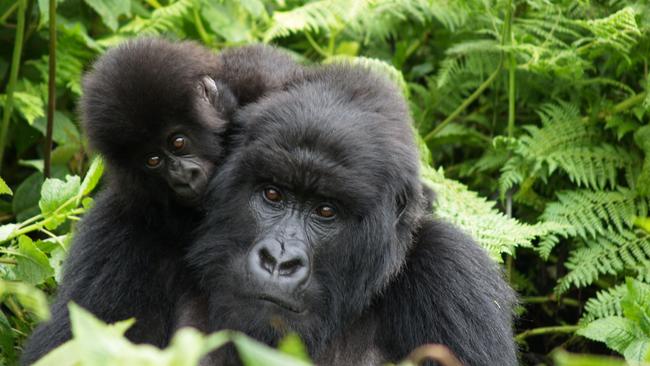
In the know
Volcanoes National Park is 105km north of Kigali, the capital of Rwanda. Donations to research can be made to the Dian Fossey Gorilla Fund, which also offers an “adoption” scheme. Gorilla Doctors is a not-for-profit organisation with a team in Rwanda that closely monitors the health of the animals and posts regular updates on Instagram: @gorilladoctors
Climbers need a reasonable degree of fitness, heavy-duty boots, thick socks and waterproof jacket. A walking pole/stick can be hired on site. The government officially allows just 80 pre-booked permits a day, although it seems flexible. The next Captain’s Choice African Adventures by Private Jet and Rovos Rail from Cairo to Cape Town tour departs September 2, 2025. Check website for pricing and inclusions.
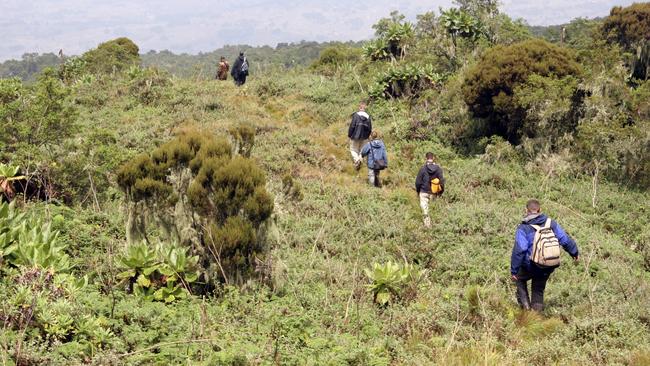
WHERE TO SEE OTHER PRIMATES
Adventurous travellers can venture further afield to see other varieties of apes and monkeys. In most national parks, permits are required. It’s recommended to book with a specialist adventure operator. Check the Australian Department of Foreign Affairs Smartraveller site for travel advice alerts, particularly Uganda, where violent crime and civil unrest are commonplace.
smartraveller.gov.au

GOLDEN MONKEYS
Uganda: Mgahinga National Park in the country’s southwest is the unique high-altitude home of the golden monkey species, of which an estimated 3000 prowl the lofty bamboo forests; the Uganda Wildlife Authority limits ranger-led tourist groups to six people on early-morning climbs, with viewing sessions limited to one hour. The relatively small park is also home to a habituated group of mountain gorillas.
SNOW MONKEYS
Japan: Japan’s snow-adapted macaque monkeys are ideally seen in the northern winter, December-March, when they bathe in hot thermal pools at destinations such as Jigodukani Monkey Park, a conservation and research facility in Nagano prefecture on the main island of Honshu. The breed is sustainably stable and, although not endemic to the northernmost island of Hokkaido, a troupe of up to 100 hangs about the hot springs pools in Hakodate Botanical Gardens.
GORILLAS
Uganda: Despite the off-putting name of Bwindi Impenetrable Forest National Park, this 32,000ha primeval expanse in the country’s southwest, a slew of operators offer treks year-round through high-altitude forested slopes; expect to spend about five hours, with a top level of fitness recommended.
Democratic Republic of the Congo: Critically endangered western lowland gorillas inhabit the world’s second-largest tropical rainforest in Odzala-Kokoua National Park, in the heart of the Congo basin. This biodiversity hotspot also supports forest-adapted elephants and more than 450 species of birds.
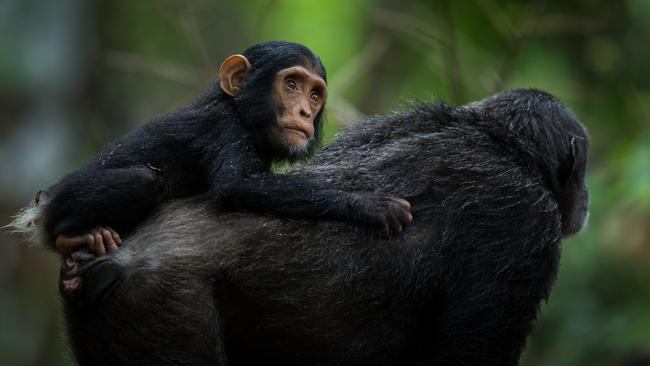
CHIMPANZEES
Tanzania: On the eastern side of Lake Tanganyika, the forested heights of Mahale Mountains National Park are where zoologist and anthropologist Jane Goodall commenced her breakthrough research in the 1960s, chronicling the social behaviours and family structures of chimps in the wild. The country’s smaller Gombe Stream National Park is home to similar species of primates, including yellow baboons. Visitors need to advance-book accommodation in both areas; in the former, I highly recommend Greystoke Mahale on
the lake shore.
RAINFOREST MONKEYS
The Amazon: This vast wilderness is home to species that include howler monkeys, capuchin and tiny squirrel monkeys, tamarins and marmosets. Consider Ecuador as an option to encounter the mantled howler and black-header spider monkey, but don’t leave it too long as the latter is critically endangered due to poaching and habitat loss.

ORANG-UTANS
Borneo: Orang-utans are present in the wilds of the Malaysian states of Sabah and Sarawak; the former has the larger population across a patrolled reserve and two designated conservation zones set aside for wildlife management, including Danum Valley, a primary lowland rainforest reserve that also has a population of proboscis monkeys and a rainforest research centre. Sarawak’s Batang Ai National Park is home to an estimated 1000 orang-utans. The species can also be found in smaller populations in Kalimantan on the Indonesian side of Borneo.
GIBBONS
Cambodia, China and Myanmar: Veun Sai-Siem Pang Conservation area in the Ratanakiri province of northeast Cambodia is home to an estimated 500 groups of lean and long-limbed northern yellow-cheeked gibbons, the world’s largest known population. Endangered forest-dwelling hoolock gibbons are present in Myanmar and China’s Yunnan province and categorised as lesser apes because of their relatively small size. One species of arboreal hoolocks has also been dubbed Skywalkers, thanks to their apparent resemblance to Ewoks, the furry creatures featured in Star Wars films. A small population of the Hainan species of gibbon is present on China’s Hainan Island, the republic’s southernmost point.
Susan Kurosawa was a guest of Captain’s Choice.
If you love to travel, sign up to our free weekly Travel + Luxury newsletter here.


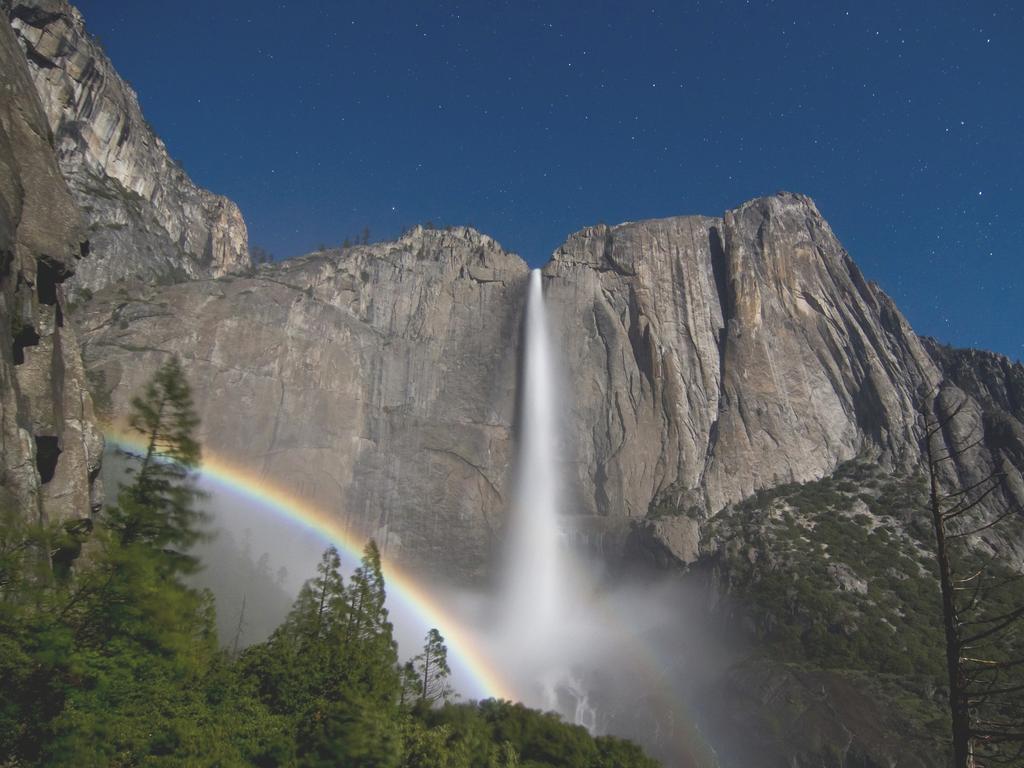

To join the conversation, please log in. Don't have an account? Register
Join the conversation, you are commenting as Logout